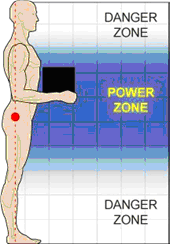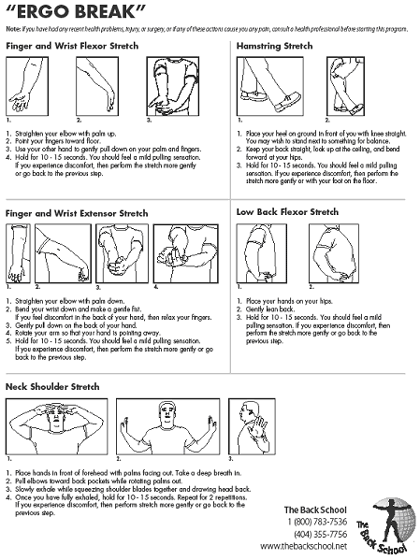
Ronald W. Porter is a recognized expert in the field of
Occupational Safety and Health, and Ergonomics. In the past
30 years, since becoming Director of the
The Back School, he has instructed over 1000 workshops and
seminars on Ergonomics Awareness and Musculoskeletal
Disorder Prevention to physical and occupational therapists,
medical doctors, occupational health nurses, and industrial
health and safety professionals. Ron has worked with over
200 industries, including Lockheed Martin Aeronautics, E.I.
Du Pont, DS Waters, Shell Oil, International Paper, Cingular
Wireless and the United States Navy, on the development and
implementation of innovative ergonomics programs for both
individual plant sites and entire corporations. He is often
an featured presenter at national safety and health
association conferences including the 2007 - 2010 American
Society of Safety Engineers Professional Development
Conferences, the 1995 - 2005 American Occupational Health
Conferences, SEAK Annual National Workers' Compensation and
Occupational Medicine Conferences in 2005-2007 and a March
2010 national webinar on the Aging Workforce for the ASSE
Virtual Classroom. His Bachelor of Science degree is from
the University of Tennessee-Knoxville and his Graduate
Degree in Physical Therapy from Emory University in Atlanta,
GA. He is a member of the Human Factors and Ergonomics
Society, American Physical Therapy
Association, American Society of Safety Engineers and the
American Industrial Hygiene Association.
| |
|
Ergonomics for the Dental
Profession |

Dentistry receives many accolades with regard to the
preventative orientation of its patient care and
public health activities. It is ironic that there has been
little focus to the prevention of adverse
health consequences among the practitioners of dentistry,
dental hygiene and associated occupations.
The mental and emotional stresses associated with the
clinical practice of dentistry have been widely appreciated
for many years. Dental professionals face many unique and
challenging ergonomics risks. Understanding and using
correct ergonomics techniques and equipment will improve
productivity and reduce fatigue and discomfort caused by the
job demands of dentists, dental hygienists and dental
assistants.
The goal of this article is to provide “doable” techniques
and tips that will help the dental professional perform
dentistry more comfortably. Good ergonomics can increase the
longevity of any professional career.
According to 2011 University of British Columbia article on,
Improving Dental Ergonomics by Loraine Chan, 67% of dentists
report experiencing musculoskeletal disorders, 80% of
hygienists report experiencing body and back pain and 70% of
3rd year students report experiencing neck, shoulder, and
back pain. Three out of five dentists (60%) and 3 out of 4
hygienists (76%) reported that they “Lived with the pain
(tolerated it).” These percentages are unacceptable and they
can be overcome through changes in worker’ habits. In fact,
Nations Business, 1990 Mar, suggests that Injury Risk at
work is 80% habit related and 20 % work design related.
Ergonomics considers the match between the person, the
equipment they use, the work processes and the work
environment. Ergonomics principles are used to improve the
“fit” between the worker and the workplace. A person’s
capabilities, physical attributes, and work habits must be
recognized to improve ergonomics factors in the workplace.
The primary ergonomics risk factors are: Posture-
awkward or static positions: Force- grip,
pinch, lift, push / pull, carry: Repetition-
frequency, speed and duration without adequate rest:
Contact/Impact Stress- focused sustained pressure
or suddenly applied with a compressive force:
Vibration- segmental or whole body over time,
frequency and amplitude. A dental professional is exposed to
all of these ergonomics risk factors on a daily basis in
their practice.
The Dental Research Journal 2012 Jan-Mar; 9(1):2-7 stated
that the risk factors for physiological damage and pain to
dental professionals include the following:
• Biomechanics of seated work postures
• Repeated unidirectional trunk twisting
• Static Postures
• Flexibility and core strength
• Operator’s knowledge on how to adjust ergonomic chairs and
equipment
There are other ergonomics risk factors that are not
contained within the work place and they include physical
fitness levels, age, obesity, static home postures, and even
the stresses of family life. They are very important for
your consideration, as well.
The POWER ZONE

Our body is a tremendous machine! That being said, it is
capable of more when used properly. Within the field of
Ergonomics, our most powerful posture is stated to be within
the body’s POWER ZONE. We are much stronger when the hands
are held closer to our body than when they are held farther
away. Increasing the distance between the hands and the body
increases the stress on the shoulders, neck and lower back.
Awareness of your POWER ZONE and your posture will help you
be more comfortable during any activity.
ERGO BREAK FOR THE WORKPLACE ATHLETE
Dentistry is a tough job that is often engaged in for 8 or
more hours a day. Yet unlike an athlete, we often do not
prepare our bodies for the awkward postures and exertions
from a day at work. Think of Dentistry as a sport. If you’re
running 5 miles or playing tennis, you should do some
warm-up or stretches to get your muscles and body ready for
the task. It makes sense to do some dental warm-up and
stretching, as well. We call it an ERGO BREAK. The following
page details some specific stretches that have benefitted
many. They are easy to do on your own in just a few minutes
a day or even between patients. Some practices have
implemented ERGO BREAK as a team building activity in the
morning.
In summary, applying good ergonomics principles in the
dental profession or any profession will decrease fatigue,
increase productivity and decrease the risk of the
individual developing discomfort or pain. Practice these
principles and enjoy a long healthy career and life.

Last revised: December 28, 2016
by Ronald Porter, PT, CEAS III










